 Do you run Facebook ad campaigns?
Do you run Facebook ad campaigns?
Wondering how many times your audience should see your ads?
In this article, you'll discover what marketers need to know about managing the frequency of Facebook ads.
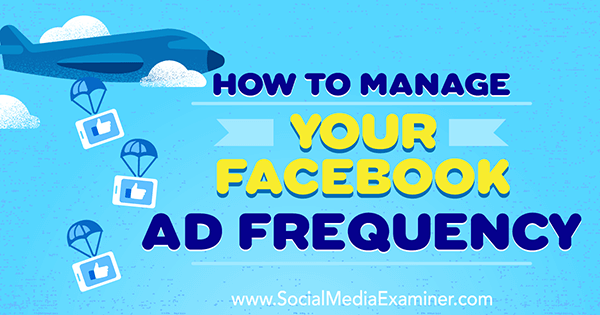
Why Ad Frequency Matters
Facebook defines “ad frequency” as the average number of times users see your ad. As an advertiser, you need to know how many times you should show your ad to a user before the user notices the ad and hopefully takes action.
Traditional advertising research has shown that optimal ad frequency is at least three exposures within a brand purchase cycle. Traditional advertising schools say that you need to “hit” your audience with the same ad as many times as possible. However, repeat exposure on Facebook might actually hurt your campaign.
Unlike traditional advertising, Facebook ads are interactive. Facebook users can submit ad feedback, and negative feedback will make your relevance score plummet. Many advertisers compete for the same audience every day, and relevance score is one of the tools Facebook uses to prioritize which ads get served first and at what price points.
For example, if someone doesn't like your ad, they have the option to hide it.
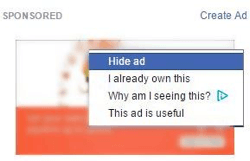
When users choose to hide ads, Facebook asks them to specify what they don't like about the ad. They can choose from options like It's Not Relevant to Me, I Keep Seeing This, or It's Annoying or Not Interesting, among others.
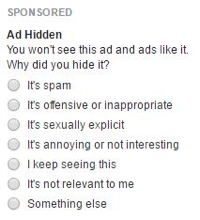
If a user submits feedback on your ad and reports It's Not Relevant to Me, your relevancy score will go down. Conversely, people who engage with your ad cause the relevancy score to go up. If your ad's relevance score is high (with 10 being the highest), your ad is more likely to be served than other ads targeting the same audience.
It translates into a lower cost per 1,000 impressions (CPM) and lower cost per 1,000 people reached.

Manage Your Own Facebook Ad Frequency
What is the connection between ad frequency and relevance score? In most cases, the higher the frequency, the lower the relevance score. Your ad might have a high relevance score (for example, 7 or 8) in the beginning, but after your ad runs for a while and gets served to the same audience several times, your relevance score will most likely go down.

I spoke with several Facebook representatives about the optimal frequency. While some at Facebook suggest keeping frequency to less than or equal to 2, others gave a tipping point of 3.4, meaning that your ad becomes ineffective after you serve it to the same audience three or four times.
Key Takeaway: To find the tipping point for your own ads, monitor the Relevancy Score for each ad.
Get World-Class Marketing Training — All Year Long!
Are you facing doubt, uncertainty, or overwhelm? The Social Media Marketing Society can help.
Each month, you’ll receive training from trusted marketing experts, covering everything from AI to organic social marketing. When you join, you’ll also get immediate access to:
- A library of 100+ marketing trainings
- A community of like-minded marketers
- Monthly online community meetups
- Relevant news and trends updates
For example, if you create a website clicks or impressions campaign, you can watch your ad's performance closely and manually stop the campaign if you notice your frequency going overboard and your relevancy score going down. For better results, you can adjust your targeting or creative, and relaunch the campaign.
Let Facebook Manage Your Facebook Ad Frequency
If frequency plays such an important role in your overall ad performance, is there a way to control it? The answer is yes and no. You can rely on Facebook to optimize frequency for a single delivery option: website clicks, impressions, or daily unique reach. Let's briefly review each option from a frequency standpoint.

Discover Proven Marketing Strategies and Tips
Want to go even deeper with your marketing? Check out the Social Media Marketing Podcast! Publishing weekly since 2012, the Social Media Marketing Podcast helps you navigate the constantly changing marketing jungle, with expert interviews from marketing pros.
But don’t let the name fool you. This show is about a lot more than just social media marketing. With over 600 episodes and millions of downloads each year, this show has been a trusted source for marketers for well over a decade.

Link Clicks to Your Website
When you optimize for Link Clicks to Your Website, you pay per click. Facebook will display your ad to the same group of people until you exhaust your budget or your ad runs out of time. There is no limit on frequency. However, Facebook starts to serve your ad less often after you've shown your ad to the same audience more than 3-4 times.
Impressions
With the Impressions option, you pay per thousand impressions and it's typically recommended for building brand awareness. Campaigns optimized for impressions also don't limit ad frequency. Remember, it's easy to wear out your audience if you don't watch your frequency closely.
To avoid overburdening its users, Facebook set limits on the number of times your audience can see an ad per day if you're running website clicks or impressions campaigns. As reported by a Facebook representative, your page's fans can see your ad up to 4 times a day, and non-fans could be exposed to an ad up to 2 times a day.
It's important to note that these rules don't apply to the right column placement and to small audiences (fewer than 5,000). Facebook recommends ad sets that will reach 1-3 million users.
Daily Unique Reach
While there isn't a magic button that will automatically pause your ad campaign after your frequency reaches a certain point, there is an option to optimize your ad delivery to Daily Unique Reach. This means Facebook will serve your ad to the maximum number of people within your selected audience, but no more than once a day. Your daily frequency is limited to 1 per day, and it applies to all placements, including the right column.
The downside of Daily Unique Reach is that Facebook no longer optimizes the ad for an action, and you may see fewer clicks or engagements (likes, comments, and shares).
However, it's still a good idea to choose this option if you have a large enough lead list you can use for building a custom audience. Custom audiences and lookalike audiences typically perform better than general Facebook targeting. But if you don't own a high-quality list, you may consider adding specific interests and behavioral targeting to increase your chances of recipients taking action on the ad.
To choose it in Facebook Ads Manager, go to Edit Ad Set, then Optimization & Pricing, and click Daily Unique Reach.
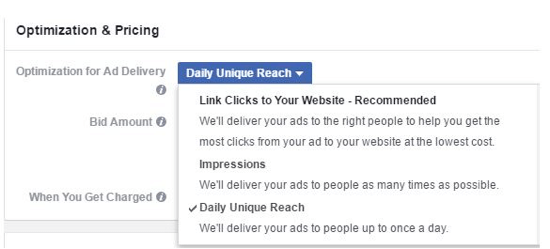
Conclusion
It's important to keep ad frequency in mind when launching and monitoring an ad campaign on Facebook. Facebook frequency often affects relevance score, which will drive the ad's cost and performance up or down.
According to Facebook, the optimal ad frequency is between 1 and 2 exposures during the length of the campaign with a tipping point of 3.4, after which an ad loses its effectiveness.
Keep in mind that it's possible to automatically cap a frequency at 1 exposure per user per day by choosing a Unique Daily Reach goal, but this option is not compatible with other campaign goals such as website clicks or impressions.
What do you think? Would it be helpful if Facebook offered an option to cap ad frequency at a custom number while running website clicks or impressions campaigns? Would it save you some time? Please share your thoughts in the comments below!
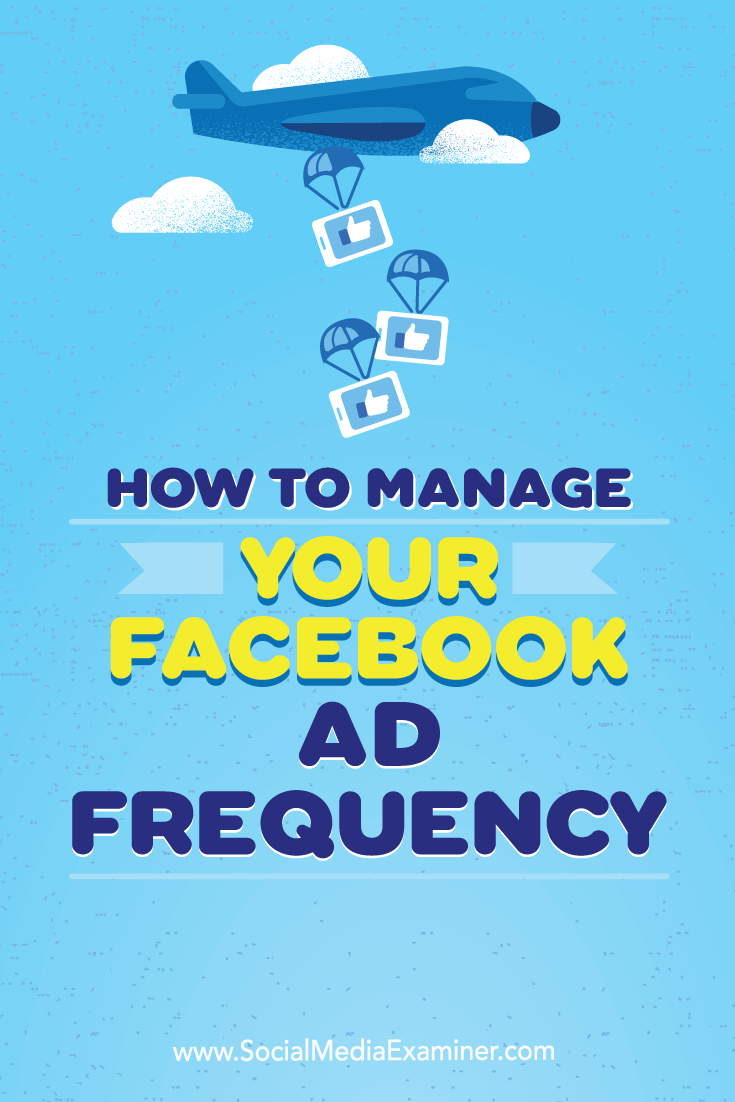
Attention Agency Owners, Brand Marketers, and Consultants

Introducing the Marketing Agency Show–our newest podcast designed to explore the struggles of agency marketers.
Join show host and agency owner, Brooke Sellas, as she interviews agency marketers and digs deep into their biggest challenges. Explore topics like navigating rough economic times, leveraging AI, service diversification, client acquisition, and much more.
Just pull up your favorite podcast app, search for Marketing Agency Show and start listening. Or click the button below for more information.

